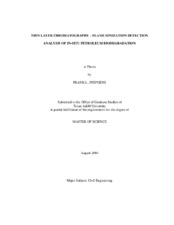| dc.description.abstract | This research was initiated after a 100-year flood caused an oil spill on the San Jacinto River (Houston, Texas) in October of 1994. After the floodwaters subsided the released petroleum floating on the water was deposited on the surrounding lands. The petroleum spill was used as an opportunity to research intrinsic petroleum biodegradation in a 9-acre petroleum impacted estuarine wetland. The first phase of this research (Phase I) began in December 1994, approximately 1.5 months after the spill of opportunity and involved the study and quantification of in-situ petroleum biodegradation. The second phase of the research (Phase II) began in March 1996 with a controlled oil release to study and evaluate the success of two bioremediation treatments versus natural biodegradation. The study of in-situ petroleum hydrocarbon degradation and the evaluation of bioremediation amendments were successfully quantified using GC-MS analytical techniques. However, the GC-MS technique is limited to the analyses of hydrocarbon compounds, a disadvantage that precludes the overall characterization of petroleum degradation.
The research presented here details an analytical technique that was used to provide a full characterization of temporal petroleum biodegradation. This technique uses thin layer chromatography coupled with flame ionization detection (TLC-FID) to characterize the saturate and aromatic (hydrocarbon) fractions and the resin and asphaltene (non-hydrocarbon, polar) fractions. Other analysis techniques, such as HPLC-SARA analysis, are available for the full characterization of the four petroleum fractions. However, these techniques do not lend themselves well to the application of large sample set analysis.
A significant advantage of the TLC-FID analysis to other petroleum analysis techniques is the ability to analyze several samples concurrently and quickly with relative ease and few resources. For the purposes of the Phase I and Phase II research the TLC-FID analysis method was evaluated, refined and applied to quantify the temporal biodegradation and bioremediation of petroleum. While the TLC-FID analysis produces a full characterization, it cannot supplant the GC-MS analysis for petroleum bioremediation research. However, it can be used in conjunction with the GC-MS to expand the knowledge of petroleum bioremediation and remediation strategies. | en |


